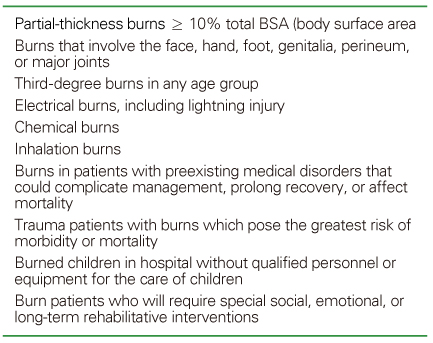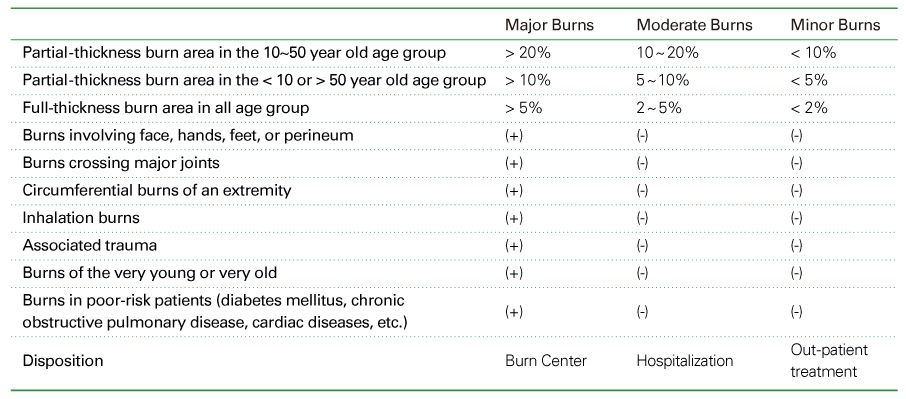 |
 |
- Search
| J Korean Med Assoc > Volume 53(4); 2010 > Article |
Abstract
Recently burn care system in Korea has been changing from 'general care' to 'specialized care'. Consequently, most physicians and surgeons who do not work in burn centers could rarely have an opportunity to gain experience in burn care. Before being transferred to a burn center, every burn patient is usually treated primarily by the non-experts. Therefore, all primary physicians need to know the primary care for burns. The main components of the primary care are pre-hospital care, emergency room (ER) care, and decision-making process for the transfer of the patients to a burn center. Pre-hospital care and ER care are on the same spectrum, and composed of the advanced trauma life support (ATLS) primary survey, wound cooling, pain control, fluid therapy, high concentration oxygen therapy, cyanide antidote therapy, and burn wound care including escharotomy. Rapid and proper management for smoke inhalation is essential for acute stage survival of burn patients. Once the patient is stabilized, a decision regarding his/her disposition to a burn center is critical. Inappropriate transfer of minor burn patients to burn centers imposes unnecessary cost and discomfort to the patients. The primary care for burns is very important and medical personnel who are in charge of burn patients should be familiar with it.
References
1. Singer AJ, Taira BR, Lee CC, Soroff HS. In: Marx JA, editor. Thermal burns. Rosen's emergency medicine: concept and clinical practice 2010;7th ed. Philadelphia: Mosby Elsevier. 758-766.
2. In: Salomone JP, Pons PT, editor. Burn trauma. PHTLS 2007;6th ed. St. Louis: Mosby Elsevier. 332-353.
3. Alson RL. In: Campbell JE, editor. Burns. BTLS 2004;6th ed. Upper Saddle River: Pearson Prentice Hall. 221-241.
4. Lee JO, Herdon DN. In: Feliciano DV, Mattox KL, Moore EE, editor. Burns and radiation injuries. Trauma 2008;6th ed. New York: McGraw Hill Medical. 1051-1066.
5. Nelson LS, Hoffman RS. In: Marx JA, editor. Inhaled toxins. Rosen's emergency medicine: concept and clinical practice 2010;7th ed. Philadelphia: Mosby Elsevier. 2031-2038.
6. Levine M, Zane R. In: Marx JA, editor. Chemical injuries. Rosen's emergency medicine: concept and clinical practice 2010;7th ed. Philadelphia: Mosby Elsevier. 767-777.
7. Schwartz LR, Balakrishnan CB. In: Tintinalli JE, editor. Thermal burns. Emergency medicine: a comprehensive study guide 2004;6th ed. New York: McGraw Hill. 1220-1226.
Table 2
American Burn Association Burn Center Referral Criteria

source: American Burn Association, www.ameriburn.org
- TOOLS
-
METRICS

-
Related articles in
J Korean Med Assoc -
Primary Care Physician1999 May;42(5)







